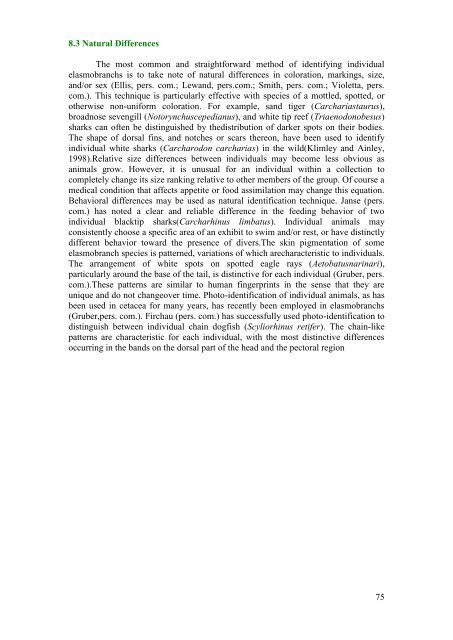standardization of records keeping in indian zoos - Central Zoo ...
standardization of records keeping in indian zoos - Central Zoo ...
standardization of records keeping in indian zoos - Central Zoo ...
You also want an ePaper? Increase the reach of your titles
YUMPU automatically turns print PDFs into web optimized ePapers that Google loves.
8.3 Natural Differences<br />
The most common and straightforward method <strong>of</strong> identify<strong>in</strong>g <strong>in</strong>dividual<br />
elasmobranchs is to take note <strong>of</strong> natural differences <strong>in</strong> coloration, mark<strong>in</strong>gs, size,<br />
and/or sex (Ellis, pers. com.; Lewand, pers.com.; Smith, pers. com.; Violetta, pers.<br />
com.). This technique is particularly effective with species <strong>of</strong> a mottled, spotted, or<br />
otherwise non-uniform coloration. For example, sand tiger (Carchariastaurus),<br />
broadnose sevengill (Notorynchuscepedianus), and white tip reef (Triaenodonobesus)<br />
sharks can <strong>of</strong>ten be dist<strong>in</strong>guished by thedistribution <strong>of</strong> darker spots on their bodies.<br />
The shape <strong>of</strong> dorsal f<strong>in</strong>s, and notches or scars thereon, have been used to identify<br />
<strong>in</strong>dividual white sharks (Carcharodon carcharias) <strong>in</strong> the wild(Klimley and A<strong>in</strong>ley,<br />
1998).Relative size differences between <strong>in</strong>dividuals may become less obvious as<br />
animals grow. However, it is unusual for an <strong>in</strong>dividual with<strong>in</strong> a collection to<br />
completely change its size rank<strong>in</strong>g relative to other members <strong>of</strong> the group. Of course a<br />
medical condition that affects appetite or food assimilation may change this equation.<br />
Behavioral differences may be used as natural identification technique. Janse (pers.<br />
com.) has noted a clear and reliable difference <strong>in</strong> the feed<strong>in</strong>g behavior <strong>of</strong> two<br />
<strong>in</strong>dividual blacktip sharks(Carcharh<strong>in</strong>us limbatus). Individual animals may<br />
consistently choose a specific area <strong>of</strong> an exhibit to swim and/or rest, or have dist<strong>in</strong>ctly<br />
different behavior toward the presence <strong>of</strong> divers.The sk<strong>in</strong> pigmentation <strong>of</strong> some<br />
elasmobranch species is patterned, variations <strong>of</strong> which arecharacteristic to <strong>in</strong>dividuals.<br />
The arrangement <strong>of</strong> white spots on spotted eagle rays (Aetobatusnar<strong>in</strong>ari),<br />
particularly around the base <strong>of</strong> the tail, is dist<strong>in</strong>ctive for each <strong>in</strong>dividual (Gruber, pers.<br />
com.).These patterns are similar to human f<strong>in</strong>gerpr<strong>in</strong>ts <strong>in</strong> the sense that they are<br />
unique and do not changeover time. Photo-identification <strong>of</strong> <strong>in</strong>dividual animals, as has<br />
been used <strong>in</strong> cetacea for many years, has recently been employed <strong>in</strong> elasmobranchs<br />
(Gruber,pers. com.). Firchau (pers. com.) has successfully used photo-identification to<br />
dist<strong>in</strong>guish between <strong>in</strong>dividual cha<strong>in</strong> dogfish (Scyliorh<strong>in</strong>us retifer). The cha<strong>in</strong>-like<br />
patterns are characteristic for each <strong>in</strong>dividual, with the most dist<strong>in</strong>ctive differences<br />
occurr<strong>in</strong>g <strong>in</strong> the bands on the dorsal part <strong>of</strong> the head and the pectoral region<br />
75
















